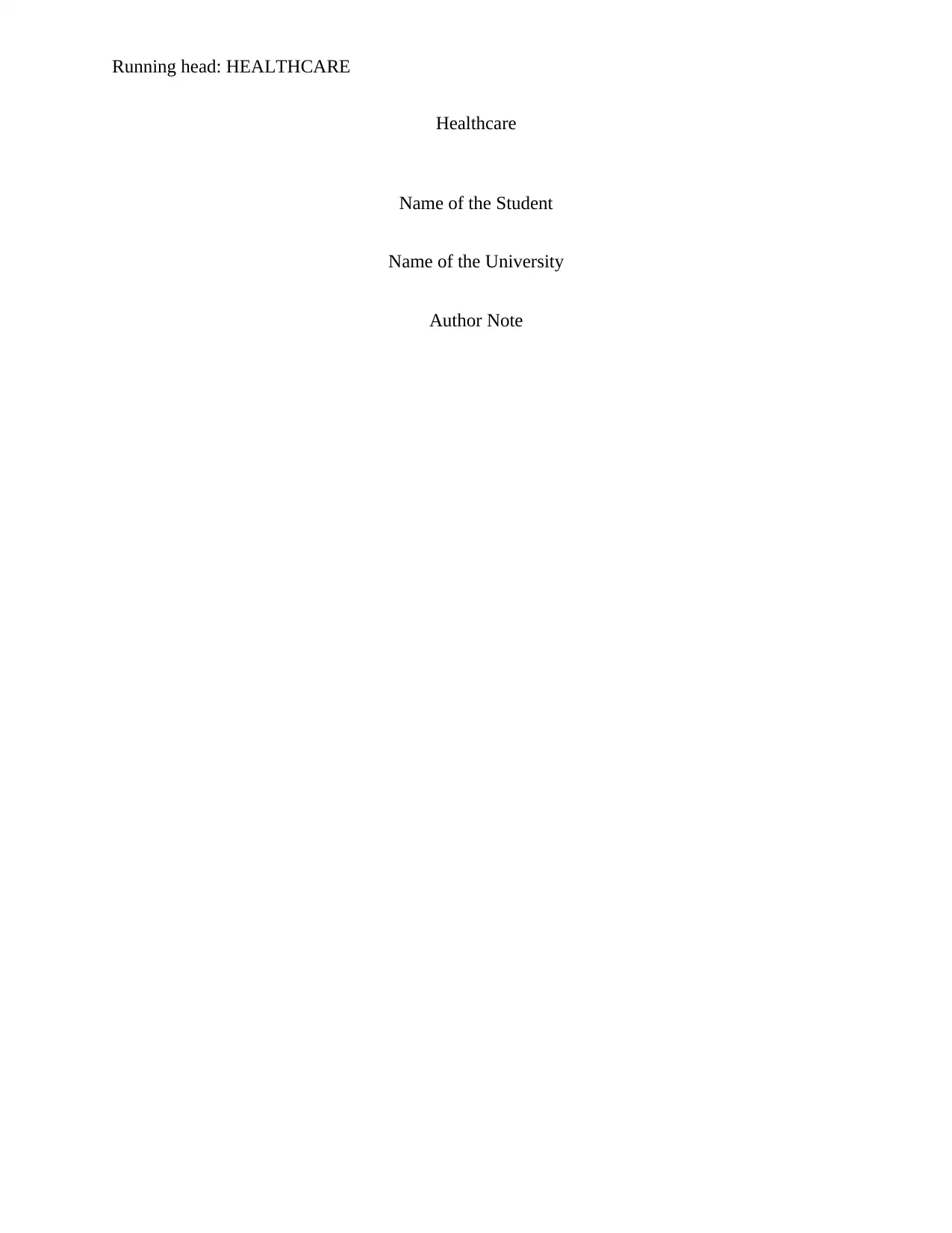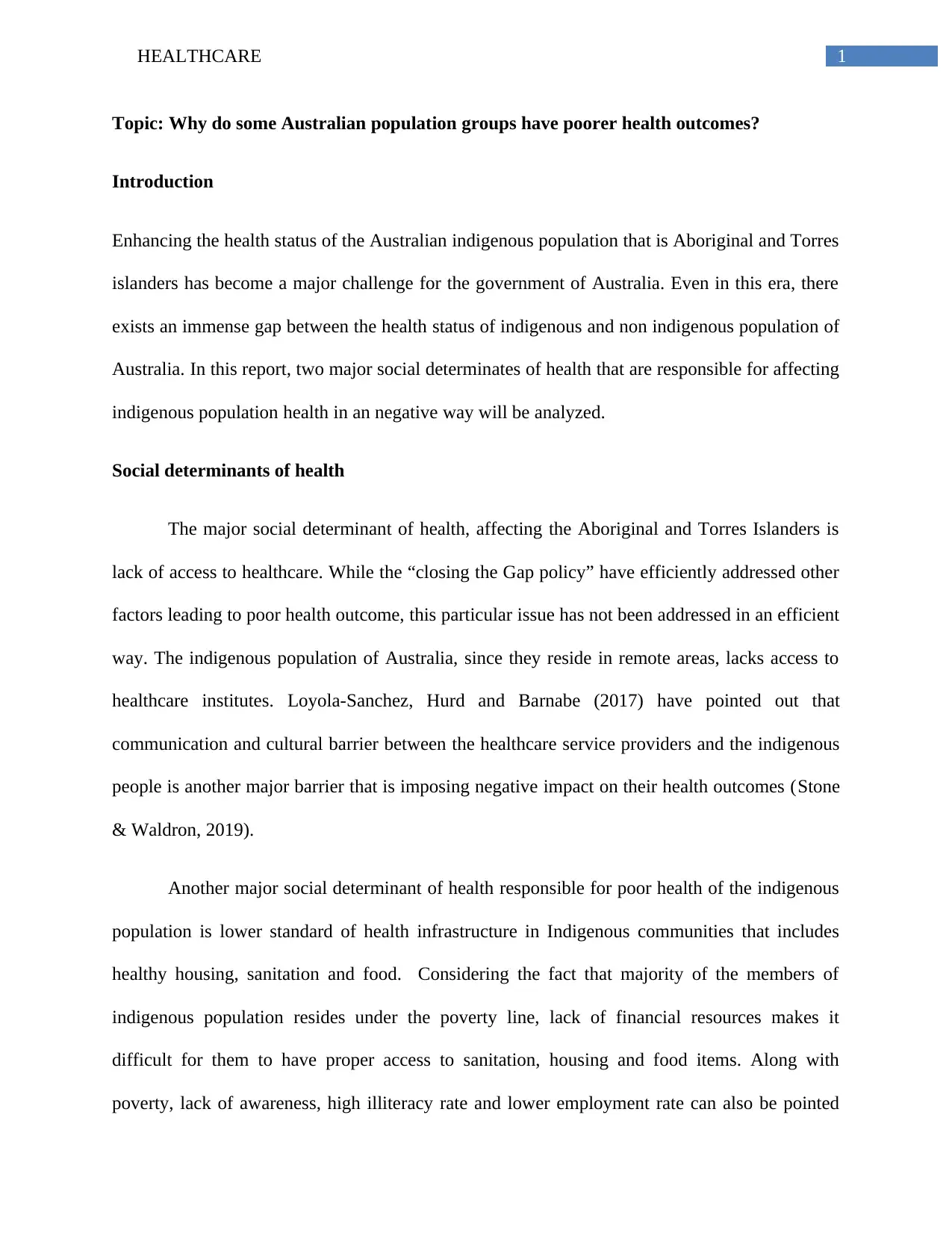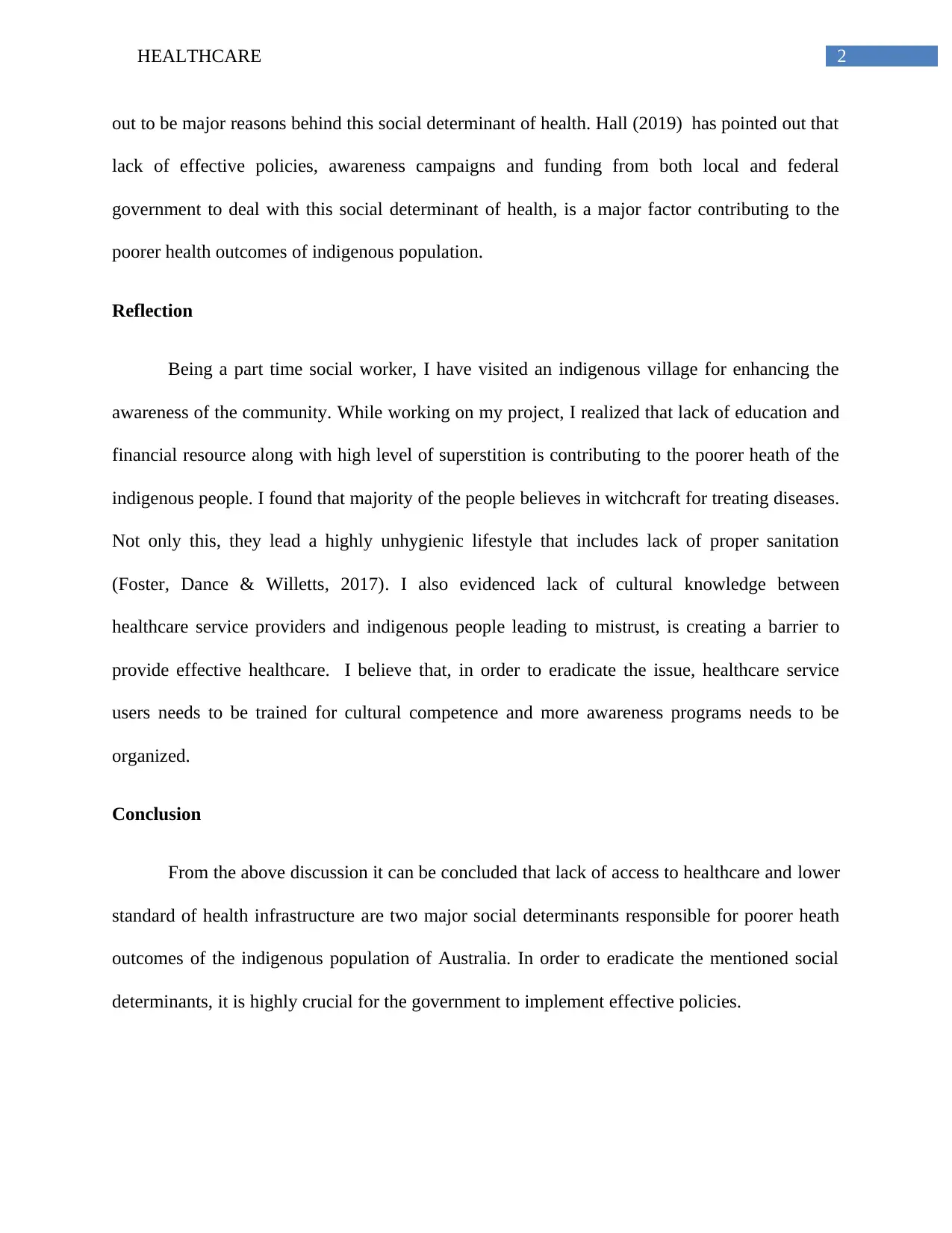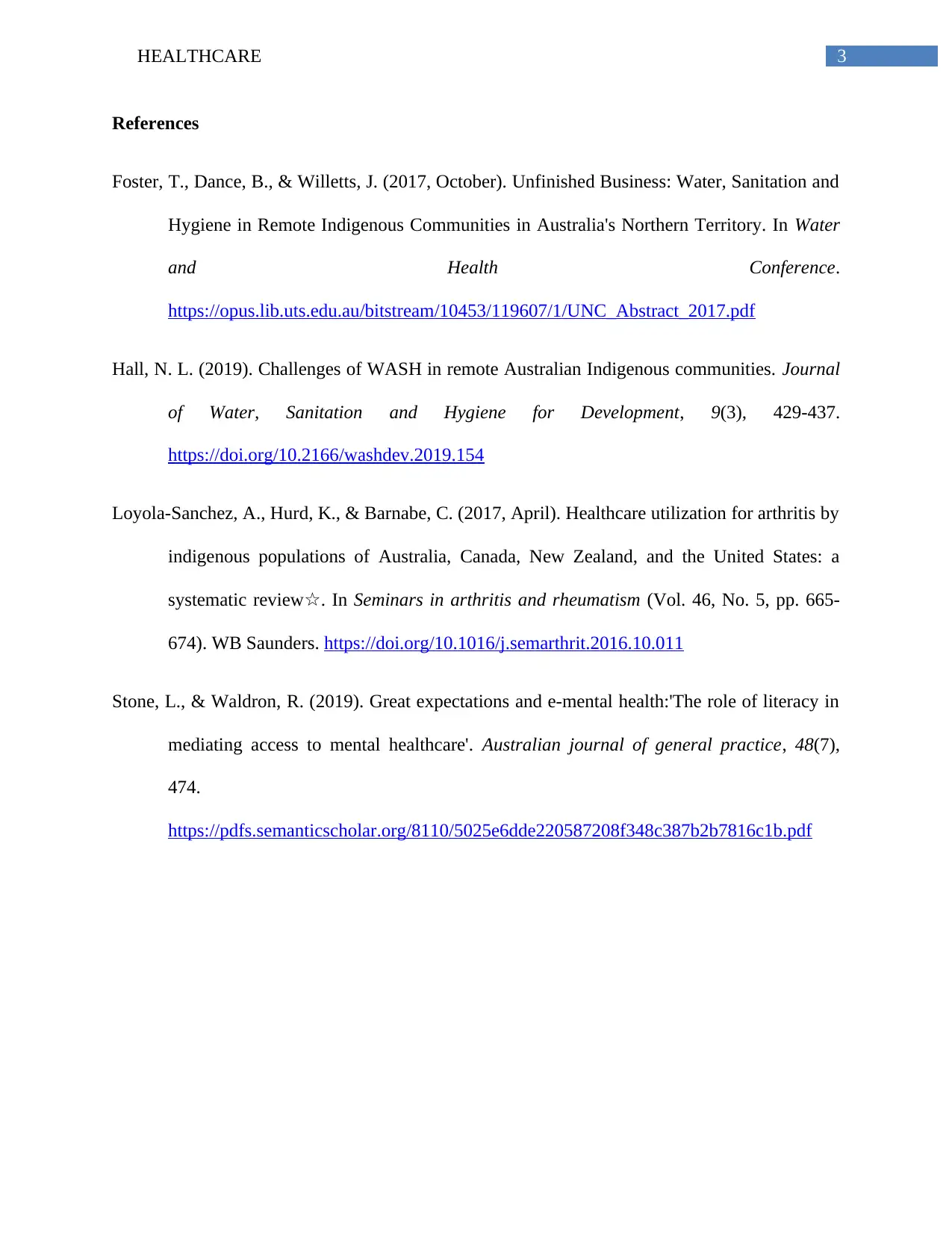Why Australian Population Groups Experience Poorer Health Outcomes?
VerifiedAdded on 2022/09/12
|5
|779
|22
Essay
AI Summary
This essay examines the poorer health outcomes of some Australian population groups, particularly the Indigenous population. It identifies two key social determinants of health: lack of access to healthcare, especially in remote areas, and lower standards of health infrastructure, including housing, sanitation, and food. The essay highlights communication and cultural barriers, poverty, and lack of awareness as contributing factors. A reflective section provides a personal experience, emphasizing the impact of education, financial resources, and cultural beliefs on health. The conclusion stresses the need for effective government policies to address these social determinants and improve health outcomes. The essay is supported by academic sources and follows APA formatting.

Running head: HEALTHCARE
Healthcare
Name of the Student
Name of the University
Author Note
Healthcare
Name of the Student
Name of the University
Author Note
Paraphrase This Document
Need a fresh take? Get an instant paraphrase of this document with our AI Paraphraser

1HEALTHCARE
Topic: Why do some Australian population groups have poorer health outcomes?
Introduction
Enhancing the health status of the Australian indigenous population that is Aboriginal and Torres
islanders has become a major challenge for the government of Australia. Even in this era, there
exists an immense gap between the health status of indigenous and non indigenous population of
Australia. In this report, two major social determinates of health that are responsible for affecting
indigenous population health in an negative way will be analyzed.
Social determinants of health
The major social determinant of health, affecting the Aboriginal and Torres Islanders is
lack of access to healthcare. While the “closing the Gap policy” have efficiently addressed other
factors leading to poor health outcome, this particular issue has not been addressed in an efficient
way. The indigenous population of Australia, since they reside in remote areas, lacks access to
healthcare institutes. Loyola-Sanchez, Hurd and Barnabe (2017) have pointed out that
communication and cultural barrier between the healthcare service providers and the indigenous
people is another major barrier that is imposing negative impact on their health outcomes (Stone
& Waldron, 2019).
Another major social determinant of health responsible for poor health of the indigenous
population is lower standard of health infrastructure in Indigenous communities that includes
healthy housing, sanitation and food. Considering the fact that majority of the members of
indigenous population resides under the poverty line, lack of financial resources makes it
difficult for them to have proper access to sanitation, housing and food items. Along with
poverty, lack of awareness, high illiteracy rate and lower employment rate can also be pointed
Topic: Why do some Australian population groups have poorer health outcomes?
Introduction
Enhancing the health status of the Australian indigenous population that is Aboriginal and Torres
islanders has become a major challenge for the government of Australia. Even in this era, there
exists an immense gap between the health status of indigenous and non indigenous population of
Australia. In this report, two major social determinates of health that are responsible for affecting
indigenous population health in an negative way will be analyzed.
Social determinants of health
The major social determinant of health, affecting the Aboriginal and Torres Islanders is
lack of access to healthcare. While the “closing the Gap policy” have efficiently addressed other
factors leading to poor health outcome, this particular issue has not been addressed in an efficient
way. The indigenous population of Australia, since they reside in remote areas, lacks access to
healthcare institutes. Loyola-Sanchez, Hurd and Barnabe (2017) have pointed out that
communication and cultural barrier between the healthcare service providers and the indigenous
people is another major barrier that is imposing negative impact on their health outcomes (Stone
& Waldron, 2019).
Another major social determinant of health responsible for poor health of the indigenous
population is lower standard of health infrastructure in Indigenous communities that includes
healthy housing, sanitation and food. Considering the fact that majority of the members of
indigenous population resides under the poverty line, lack of financial resources makes it
difficult for them to have proper access to sanitation, housing and food items. Along with
poverty, lack of awareness, high illiteracy rate and lower employment rate can also be pointed

2HEALTHCARE
out to be major reasons behind this social determinant of health. Hall (2019) has pointed out that
lack of effective policies, awareness campaigns and funding from both local and federal
government to deal with this social determinant of health, is a major factor contributing to the
poorer health outcomes of indigenous population.
Reflection
Being a part time social worker, I have visited an indigenous village for enhancing the
awareness of the community. While working on my project, I realized that lack of education and
financial resource along with high level of superstition is contributing to the poorer heath of the
indigenous people. I found that majority of the people believes in witchcraft for treating diseases.
Not only this, they lead a highly unhygienic lifestyle that includes lack of proper sanitation
(Foster, Dance & Willetts, 2017). I also evidenced lack of cultural knowledge between
healthcare service providers and indigenous people leading to mistrust, is creating a barrier to
provide effective healthcare. I believe that, in order to eradicate the issue, healthcare service
users needs to be trained for cultural competence and more awareness programs needs to be
organized.
Conclusion
From the above discussion it can be concluded that lack of access to healthcare and lower
standard of health infrastructure are two major social determinants responsible for poorer heath
outcomes of the indigenous population of Australia. In order to eradicate the mentioned social
determinants, it is highly crucial for the government to implement effective policies.
out to be major reasons behind this social determinant of health. Hall (2019) has pointed out that
lack of effective policies, awareness campaigns and funding from both local and federal
government to deal with this social determinant of health, is a major factor contributing to the
poorer health outcomes of indigenous population.
Reflection
Being a part time social worker, I have visited an indigenous village for enhancing the
awareness of the community. While working on my project, I realized that lack of education and
financial resource along with high level of superstition is contributing to the poorer heath of the
indigenous people. I found that majority of the people believes in witchcraft for treating diseases.
Not only this, they lead a highly unhygienic lifestyle that includes lack of proper sanitation
(Foster, Dance & Willetts, 2017). I also evidenced lack of cultural knowledge between
healthcare service providers and indigenous people leading to mistrust, is creating a barrier to
provide effective healthcare. I believe that, in order to eradicate the issue, healthcare service
users needs to be trained for cultural competence and more awareness programs needs to be
organized.
Conclusion
From the above discussion it can be concluded that lack of access to healthcare and lower
standard of health infrastructure are two major social determinants responsible for poorer heath
outcomes of the indigenous population of Australia. In order to eradicate the mentioned social
determinants, it is highly crucial for the government to implement effective policies.
⊘ This is a preview!⊘
Do you want full access?
Subscribe today to unlock all pages.

Trusted by 1+ million students worldwide

3HEALTHCARE
References
Foster, T., Dance, B., & Willetts, J. (2017, October). Unfinished Business: Water, Sanitation and
Hygiene in Remote Indigenous Communities in Australia's Northern Territory. In Water
and Health Conference.
https://opus.lib.uts.edu.au/bitstream/10453/119607/1/UNC_Abstract_2017.pdf
Hall, N. L. (2019). Challenges of WASH in remote Australian Indigenous communities. Journal
of Water, Sanitation and Hygiene for Development, 9(3), 429-437.
https://doi.org/10.2166/washdev.2019.154
Loyola-Sanchez, A., Hurd, K., & Barnabe, C. (2017, April). Healthcare utilization for arthritis by
indigenous populations of Australia, Canada, New Zealand, and the United States: a
systematic review☆. In Seminars in arthritis and rheumatism (Vol. 46, No. 5, pp. 665-
674). WB Saunders. https://doi.org/10.1016/j.semarthrit.2016.10.011
Stone, L., & Waldron, R. (2019). Great expectations and e-mental health:'The role of literacy in
mediating access to mental healthcare'. Australian journal of general practice, 48(7),
474.
https://pdfs.semanticscholar.org/8110/5025e6dde220587208f348c387b2b7816c1b.pdf
References
Foster, T., Dance, B., & Willetts, J. (2017, October). Unfinished Business: Water, Sanitation and
Hygiene in Remote Indigenous Communities in Australia's Northern Territory. In Water
and Health Conference.
https://opus.lib.uts.edu.au/bitstream/10453/119607/1/UNC_Abstract_2017.pdf
Hall, N. L. (2019). Challenges of WASH in remote Australian Indigenous communities. Journal
of Water, Sanitation and Hygiene for Development, 9(3), 429-437.
https://doi.org/10.2166/washdev.2019.154
Loyola-Sanchez, A., Hurd, K., & Barnabe, C. (2017, April). Healthcare utilization for arthritis by
indigenous populations of Australia, Canada, New Zealand, and the United States: a
systematic review☆. In Seminars in arthritis and rheumatism (Vol. 46, No. 5, pp. 665-
674). WB Saunders. https://doi.org/10.1016/j.semarthrit.2016.10.011
Stone, L., & Waldron, R. (2019). Great expectations and e-mental health:'The role of literacy in
mediating access to mental healthcare'. Australian journal of general practice, 48(7),
474.
https://pdfs.semanticscholar.org/8110/5025e6dde220587208f348c387b2b7816c1b.pdf
Paraphrase This Document
Need a fresh take? Get an instant paraphrase of this document with our AI Paraphraser

4HEALTHCARE
1 out of 5
Related Documents
Your All-in-One AI-Powered Toolkit for Academic Success.
+13062052269
info@desklib.com
Available 24*7 on WhatsApp / Email
![[object Object]](/_next/static/media/star-bottom.7253800d.svg)
Unlock your academic potential
Copyright © 2020–2025 A2Z Services. All Rights Reserved. Developed and managed by ZUCOL.




